October 21, 2017 PAB-M10-17-NI-004
Sleepy Hollow, NY

“We were clobbered with interviews. Five in one day, all in different locations. That was the most difficult part of the trip.” – Albert Bruan, Driver (RV)
“The five-interview day was very tough. We tried to rush it; I didn’t know if the quality of the video was any good. Five was too many.” – Eugene Hsiu, Security & Logistics
“On the second day, I sent the hard drive back to the office and it had 270 gigs worth of capture.” - Brian Pierce, Videography & Filmography
“I was spent and could hardly get my questions out.” – Steve Kuehn, Reporter
“We realized we were five hours behind, and we couldn’t do this for the next 10 days. Having that experience on day two really made us tighten up our process.” – Nigel Walker, Driver (Lamborghini)

With six months of planning and the team now embarking upon their third day on the road, it was starting to feel as if the Road to BIO would never escape the northeast—and with good reason. From Boston to Pennsylvania, this initial leg would be the most bio-heavy of the entire journey—save, perhaps, for BIO itself.
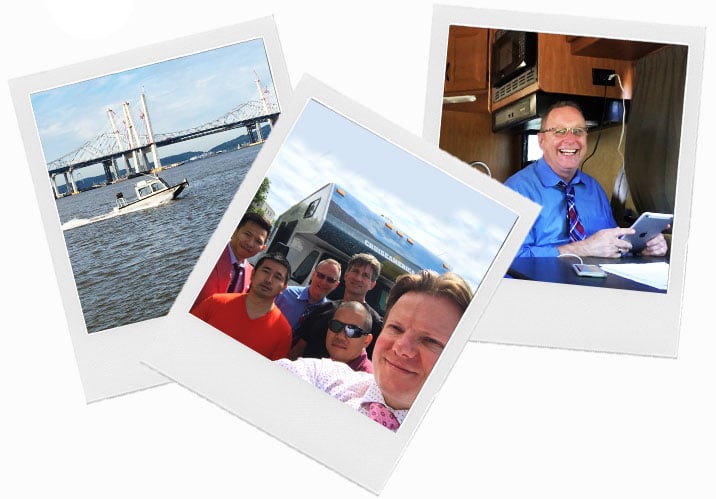
Well rested and feeling confident with three shoots under their belts, the crew hit the ground running for what would be a marathon day of interviews and, frankly, a logistical nightmare. But as the team would come to realize upon later reflection, day two of the Road to BIO was the most important day of the entire journey.
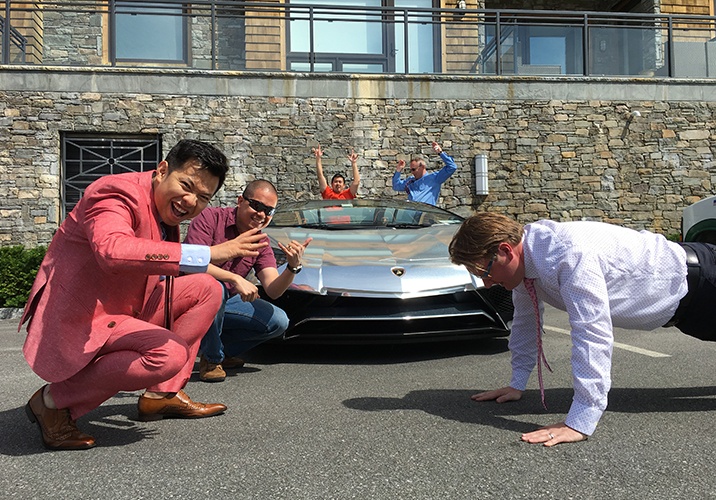
As the sun rose over New York’s Tappan Zee Bridges, with a new one currently being built to meet the demands of 10,000 daily commuters, the first sponsor of the day shed some light on why building bridges for customers in their development efforts is so important—and the reasons are not dissimilar from those necessitating the rebuild of the Tappan Zee.
Headquartered across from the famous Confederation Bridge on Prince Edward Island, Canada, is BioVectra, a three-site CDMO specializing in microbial fermentation and chemical synthesis. The choice to conduct the interview at the Tappan Zee Bridge carried meaning for a few reasons, beyond that of the obvious location parallel. Like the Tappan Zee, BioVectra’s new Windsor, Nova Scotia facility is being built to meet an ever-increasing demand—in this case, for microbial fermentation and complex chemistry capabilities. And construction analogies aside, building bridges for customers is an inherent part of BioVectra’s business model.
“We are bridge builders,” said Oliver Technow, President of BioVectra. “Building bridges between what is needed and what is expected. We put our customers and partners first in everything we do.”
Describing BioVectra as more like a quarterback than a supplier, Oliver says his team is at its best when they are sitting at the table helping to create solutions and value for customers.
“We have a relentless problem solving mentality,” said Oliver. “We sit down, listen and understand exactly what it is that needs to be done to ensure our clients get exactly what they expect from the project.”

The day was off to a great start. Oliver, who according to Nigel started the morning “about as calm as a father on his daughter’s wedding day,” turned out to be a natural in front of the camera as he discussed BioVectra’s bridge-building approach. His knowledge and charisma had made for a compelling interview, and the Road to BIO was on schedule as they themselves crossed the Tappan Zee, bound for New Jersey on one of those idyllic spring days of which the northeast is doled but a handful.

First to arrive at Envigo’s Millstone, New Jersey facility by a longshot, Nigel gave the 40 to 50 Envigo staff members who came out a lesson on the specs of the Lamborghini as they related to the inspiration for the Road to BIO, a relationship between system and speed that was all too familiar to a CRO that leads the market in preclinical trials. And in this instance, it was the girls of the group who knew more than a thing or two about the configuration of a V-12 engine.
“It was interesting to see that the female staff were the gearheads of the group,” said Nigel.
Time was ticking as the day began its initial descent into unsalvageable tardiness when Nigel noticed the first of his two significant wardrobe malfunctions on the Road to BIO. In something out of the Three Stooges, Wei had Nigel’s blue suit jacket with him in the SUV, leaving Nigel with only his black suit jacket. His pants, he realized, were blue.
Forty-five minutes after Nigel’s arrival, the Lamborghini’s clumsier cousin rolled up and secured ample production space in the Envigo parking lot, but not before plowing over the flower garden outside of the front doors. With thankfully no damage done and Nigel having resolved his fashion faux pas with Wei’s arrival shortly thereafter, the scene was quickly set and the second interview of the day was underway.
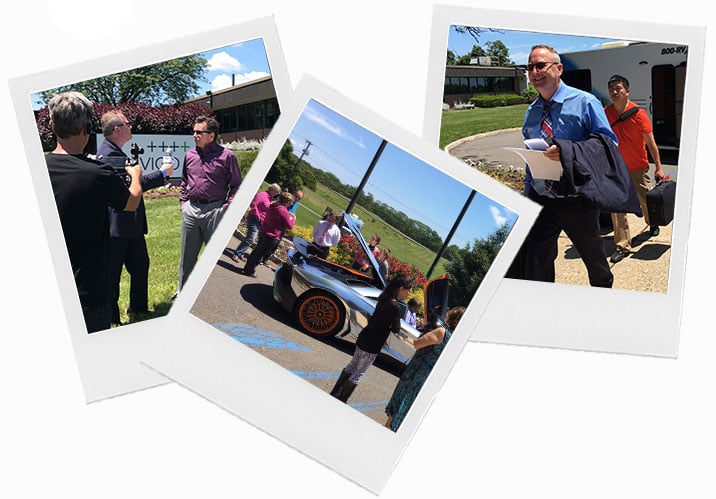
The Road to BIO may have been in New Jersey, but the heavily New York-based crew encountered one of their own in Joseph Bedford, Corporate Vice President of Strategic Marketing for Envigo and native Brooklynite. In the same vein that Joseph talked about growing up Italian in Brooklyn, he proudly described Envigo’s commitment to supporting its customers in enhancing lives and protecting the environment. “What sets Envigo apart?” is a question he and his team ask both themselves and their customers in their daily interactions. Based on this feedback, Envigo continuously strives to bring new value to its customers and to promote an overall positive experience when working with the organization.
“Since we’re one of the largest preclinical CROs, they value our expertise, experience and global capacity to get the work done,” said Joseph of Envigo’s customers. “What really sets us apart is our consultative approach and customer experience. We tend to offer a very personalized level of customer service and consulting when necessary on regulatory, technical and scientific matters.”
Perhaps the most vocally on board with the Road to BIO mission of any sponsor, Joseph thanked That’s Nice for running the “road show,” acknowledging the way biotech is revolutionizing medicine and the food supply in order to make the world a better, safer place to live.
“BIO is really the mecca of people interested in biotech,” he said. “We’re happy to be part of it, and good luck on the rest of your journey.”

Inspired by Joseph’s send-off and the energy of the Envigo team, it nearly went unrecognized by anyone that the day had fallen 90 minutes behind schedule. By the time Nigel reached Abzena’s Bristol, Pennsylvania facility, the site of the next interview on the Road to BIO, 90 minutes had become two hours. He parked the Lamborghini, assuming the RV would be along shortly.
As Nigel killed time conducting his well-practiced show-and-tell with the 20 Abzena staff members who had come out of the labs to see the car, he began to wonder about the whereabouts of the rest of his film crew. Granted, the RV topped out at about 40 percent of the Lamborghini’s max speed, but it wasn’t like Nigel could have treated the streets of Central Jersey like the Circuit de Monaco if he wanted to. So, where on earth were they?

“Whoa, whoa, whoa,” exclaimed Steve as the RV took a wide left turn, nicking the curb in front of the Tru Blue Tattoo Shop in Bristol, Pennsylvania.
Albert, to his credit, had held the reins of the RV from the time he picked it up in New Jersey three days earlier to the time of his departure in El Paso eight days later. And while everyone was mostly just grateful not to have to maneuver the behemoth, it was hard not to be a tad critical, especially as willpower began to wear thin on a day that was beginning to spiral out of control.
“You have to drive those things with a certain sense of spatial relationship,” said Steve, recalling the moment he started to feel the heat of the afternoon. “Traffic was light but we were woefully behind schedule and Albert hit top speed with the RV.”
But top speed in the RV amounted to 85 miles per hour and, factoring in the time it took to reach that number, the vehicle’s velocity was no match for the ground they needed to cover in order to save the afternoon. The crew arrived at Abzena 60 minutes after Nigel, making the running total a full three hours behind schedule. The sun was going down, leaving Sven Lee, Abzena’s Chief Business Officer, with an intermittent cloud cover for the duration of the interview. Luckily, they were dealing with pros.
“The interview went well, but only because of the polished approach from Sven and his global marketing director, Min Park,” admitted Nigel.
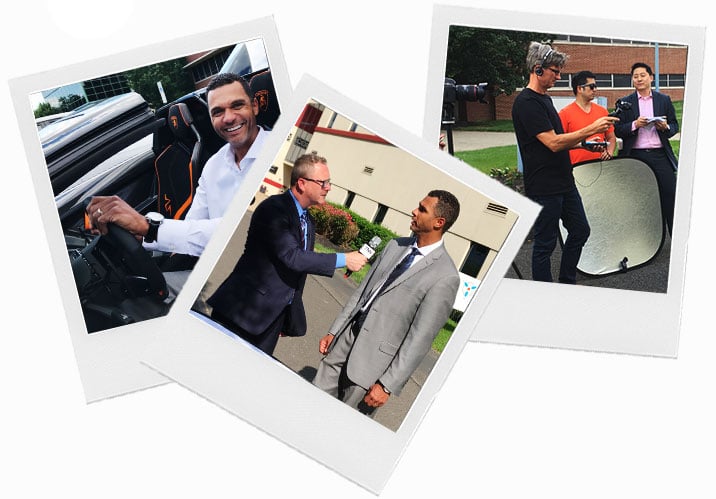
Abzena is an international life sciences services and technology group committed to the selection, development and manufacture of better biopharmaceuticals for patients. A global organization with facilities in the US and UK, Abzena is investing heavily in facilities, equipment and personnel to meet the rising demand for ADCs and biopharmaceuticals. And the investment is paying off. In 2016, the organization’s Bristol, Pennsylvania site was named “Best CRO” at the World ADC Conference.
“The ADC market is by some reports growing 20 to 40 percent over the next seven years,” said Sven. “So there is a really good opportunity there, as well as in the CDMO market for biomanufacturing, which is not quite at capacity, but is very full.”
Abzena was formed from the acquisition of four different global organizations—Antitope and PolyTherics in the UK, Pacific GMP in San Diego and TCRS in Bristol, Pennsylvania, where the organization is investing in a GMP HPAPI facility as well as a GMP bioconjugation suite.
“Our general business strategy includes lots of highly specialized and highly capable people that help integrate an end-to-end offering for our clients,” said Sven. “As we’re adding GMP bioconjugation capabilities here, we’re doing the same in San Diego where we’re adding large stir tank bioreactors to help facilitate our customers’ ability to provide more protein that could potentially be used in bioconjugation.”

Wei, whom Steve deferentially referred to on night one as “a general in command,” had arrived at Abzena even later than those in the RV after inadvertently taking the scenic tour of the greater Princeton area of New Jersey. With the day now running almost four hours behind schedule and with two more interviews to go, Wei was sent early to the next location in Plymouth Meeting, Pennsylvania to prep CRB’s Matthew Kennedy, Process Specialist and Senior Associate, and the next interviewee on the Road to BIO. But when Nigel arrived to a nearly empty CRB parking lot 45 minutes later, Matthew was the only one there to greet him. Now 7:30 p.m., the CRB staff had left for the weekend, and Wei, it seemed, was on another one of his jaunts, this time around the Quaker State. By the time the full crew had arrived, they were a full three and a half hours behind schedule.
Luckily, Matthew, both a consummate professional and self-professed gearhead, gave one of the most insightful interviews of the day on making smart manufacturing decisions before hopping in the Lamborghini for a spin around CRB’s gravel-lined parking lot. “That was worth waiting for,” Matt said, as Nigel and the crew breathed a sigh of relief.
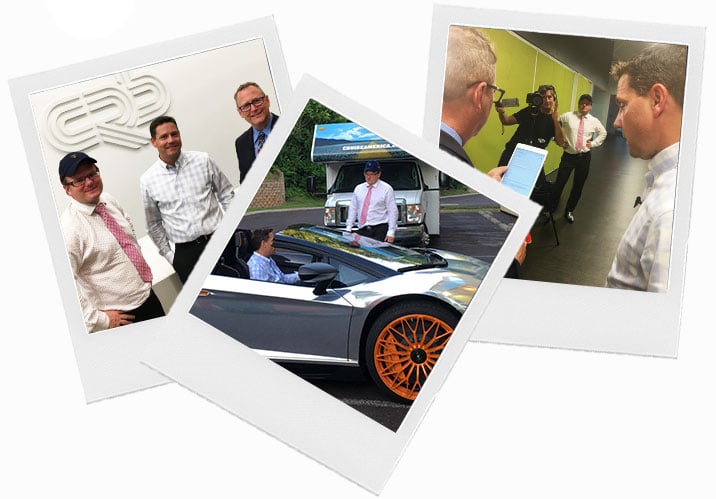
CRB is transforming the biotech industry, innovating high-quality bioprocess facilities that are safe, reliable and sustainable. With their FutureFacility™ concepts, CRB engineers are enabling customers to make smart manufacturing decisions in a field that is often wrought with uncertainty.
“To make an informed decision, companies must consider the current competitive environment, evaluate the risk of pipeline attrition and determine whether products have different variations in patient population,” said Matthew. “CRB understands that investing in manufacturing capacity amid this level of uncertainty is a challenge, and has designed FutureFacility™ concepts to help companies navigate the marketplace and make long-term investment decisions.”
Acknowledging the need to align manufacturing capacity with demand, Matt described the benefits of CRB’s FutureFacility™ designs, which are scalable and expandable, and can be rapidly deployed and set up in various parts of the world.
“There are a number of ways in which the facility design itself can be operated to respond to changes in manufacturing demand, or if new products are introduced, it can be dialed up or down in capacity within a continuous closed manufacturing setting,” he said.

Mercifully less than one mile up the road was the fifth and final interview of the day, with Kristine Senft, a veteran pharmaceutical sales and marketing executive and longtime friend of Nigel and That’s Nice. As the crew rolled up at 9 p.m.—four hours later than scheduled—Kristine, the epitome of professionalism and diplomacy, welcomed the team as if they were arriving for a regularly scheduled afternoon sales meeting. And while the crew may have been too spent to realize it at the time, the theme of the interview was not lost on those documenting the project back at the office, nor would it be on a more well-rested crew once this marathon day drew to a close.
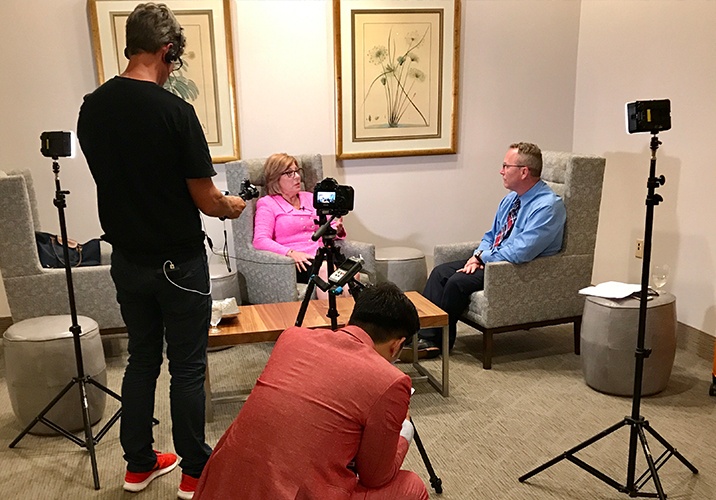
No stranger to the ever-fluctuating landscape that lines the development pathway, industry veteran Kristine Senft has held executive sales and marketing positions at several leading pharmaceutical organizations, including Hovione, DSM and Albemarle. And over the course of her 27-year career, she has learned a thing or two about how to balance rising demand with a shortage in capacity. According to Kristine, communication is key.
“In these days of tight capacity, communication between yourself and the pharma client as a CDMO service is crucial,” she said. “From an internal standpoint—and this is so very important in today’s supply and demand picture—the CDMO has to have a really robust sales and operation planning process (S&OP). This way, the commercial side of the business is in total sync with the manufacturing side of the business and also the sourcing organization with what needs to be accomplished.”
While growing your international sales force is key to achieving global expansion, if the team is disjointed, the effort is done in vain. Communication again comes into play, as Kristine emphasized the importance of constantly communicating the company’s goals, and how every individual contributes to meeting the company-wide goal.
“The key is to make sure that everybody feels like they are part of the team,” she said. “This means trying to get everyone together at least a couple of times a year, and it means ensuring those people are communicating with one another, especially if they’re working on a common global account.”

Like each of the sponsors the team had encountered on this and every day on the Road to BIO, Kristine’s reception of a crew that despite their best efforts fell far short of seamless execution, confirmed a hypothesis developed in the early stages of this campaign—that no one would understand overcoming roadblocks more than those who have themselves navigated the development pathway. Tardy and worn, the crew persevered to get the job done by whatever means necessary and no one, it would be discovered, understood this sentiment more than those on the Road to BIO.
Ironically, it was at the end of this tumultuous leg of the journey that both Nigel and Wei felt the most confident in the abilities of the team to take this journey to the finish, and it was decided that Wei could depart as scheduled.
“The most important factor of success was that the individuals who started the journey became a team very quickly,” said Nigel. “This happened on day two. If this journey was not going to become a mess, we all had to cover each other before anyone hit the ground.”
It was 11:45 p.m. as Brian and Eugene packed up their equipment for the final time that day. Looking around the hotel lobby at a visibly exhausted crew, the two wearily discussed the day behind them and anxiously anticipated the road that lay ahead. Eugene, a philosophical presence on the journey, made a most eloquent assessment.
“We need to leave time to make mistakes,” he said.

NEXT | Chapter 3: Bristol Is A Good Place To Live

As Marketing Writer, Maria works as part of the content development team on marketing copy that interprets research insights and top line strategic messaging developed by That’s Nice, while working in harmony with the visual brand and overall optimized positioning for clients. Maria previously managed marketing and communications for a corporate real estate company in New York. She has a degree in Journalism from the University of South Florida – College of Mass Communications.